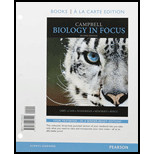
Concept explainers
Which of the following steps has not yet been accomplished by scientists studying the origin of life?
- A. synthesis of small RNA
polymers by ribozymes - B. abiotic synthesis of polypeptides
- C. formation of molecular aggregates with selectively permeable membranes
- D. formation of protocells that use DNA to direct the
polymerization of amino acids
Introduction:
In studying the evolution of life, scientists have accomplished a lot. For example: From creating the early earth atmosphere in “The Stanley Miller experiment” for reconstructing the “Structure of early human ancestors”.
Answer to Problem 1TYU
Correct answer:
Science today has advanced a lot. Polypeptides, selectively permeable membranes RNA from ribozymes have been synthesized in-vitro. Therefore, option (D) is correct.
Explanation of Solution
Reason for the correct statement:
A protocell or a protobiont was the first cell and the precursor of prokaryotes. It is made from inorganic components and bound by a lipid membrane. Scientists have not yet been able to synthesize a protocell that uses DNA for protein synthesis in the lab.
Option (D) is given as “formation of protocells that that use DNA to direct the polymerization of amino acids”.
“The formation of protocells that that use DNA to direct the polymerization of amino acids has not yet been accomplished by scientists studying the origin of life”, it is the right answer.
Hence, the option (D) is correct.
Reasons for the incorrect statements:
Option (A) is given as “synthesis of small RNA polymers by ribozymes”.
This has been accomplished by the scientists. So, it is a wrong answer.
Option (B) is given as “abiotic synthesis of polypeptides”.
The abiotic synthesis of polypeptides has been done in-vitro by the scientists. So, it is a wrong answer.
Option (C) is given as “formation of molecular aggregates with selectively permeable membrane”.
This formation of molecular aggregates with selectively permeable membrane too has been accomplished. So, it is a wrong answer.
Hence, options (A), (B) and (C) are incorrect.
In the study of origin of life, scientists have accomplished a lot but the artificial synthesis of a protocell that uses DNA for polymerization of amino acids is yet to be accomplished.
Want to see more full solutions like this?
Chapter 24 Solutions
Campbell Biology in Focus, Books a la Carte Edition; Modified Mastering Biology with Pearson eText - ValuePack Access Card - for Campbell Biology in Focus (2nd Edition)
Additional Science Textbook Solutions
Genetics: From Genes to Genomes
Microbiology Fundamentals: A Clinical Approach
Human Physiology: An Integrated Approach (8th Edition)
Campbell Essential Biology (7th Edition)
- explain the cascade of events (starting with relaxing trade winds) that occurs during El Niño in the eastern Pacific (off the coasts of California/North America and Peru/South America) and which lead to food-chain collapse - start with changes in the physical/oceanographic conditions, andthen systematically describe the cascading effects at each level of the food chain -arrow_forward3) Which statement(s) about the Pacific Decadal Oscillation (PDO) is/are TRUE? CIRCLE ALL THAT APPLY. A. It is a major driver of salmon populations in the Pacific B. It affects sea surface temperatures in the eastern Pacific C. Its cycles typically do not last as long as those of ENSO D. Evidence that it has occurred over many centuries has been gathered from tree ring dataarrow_forward4.arrow_forward
- 2arrow_forward1. 2. 3. Marine fish cells are hypotonic compared to their seawater environment; their cells lose water by osmosis and gain solutes. If you add heterotrophic respiration and autotrophic respiration together and then subtract that value from gross primary productivity, then you have a more refined estimate of ecosystem carbon storage than NEE. Differential heating due to the earth's tilt generates the global wind AND oceanic circulation patternsarrow_forward1arrow_forward
- 4arrow_forwardDoes it show the level of proteins? What about the amount? Levels of protein activation? How can you tell? Does the thickness tell you anything? What about the number of the lines? And the other questionsarrow_forwardKD 200- 116- 66- Vec ATF6 (670) ATF6 (402) ATF6 (373) ATF6 (366) I I 45- 1 2 3 4 5 ATFG (360) (e/c) 9V ATFG (402) g ant- ATF anti-KDEL DAPI barrow_forward

 Concepts of BiologyBiologyISBN:9781938168116Author:Samantha Fowler, Rebecca Roush, James WisePublisher:OpenStax College
Concepts of BiologyBiologyISBN:9781938168116Author:Samantha Fowler, Rebecca Roush, James WisePublisher:OpenStax College Human Biology (MindTap Course List)BiologyISBN:9781305112100Author:Cecie Starr, Beverly McMillanPublisher:Cengage Learning
Human Biology (MindTap Course List)BiologyISBN:9781305112100Author:Cecie Starr, Beverly McMillanPublisher:Cengage Learning Biology: The Unity and Diversity of Life (MindTap...BiologyISBN:9781305073951Author:Cecie Starr, Ralph Taggart, Christine Evers, Lisa StarrPublisher:Cengage Learning
Biology: The Unity and Diversity of Life (MindTap...BiologyISBN:9781305073951Author:Cecie Starr, Ralph Taggart, Christine Evers, Lisa StarrPublisher:Cengage Learning Biology (MindTap Course List)BiologyISBN:9781337392938Author:Eldra Solomon, Charles Martin, Diana W. Martin, Linda R. BergPublisher:Cengage Learning
Biology (MindTap Course List)BiologyISBN:9781337392938Author:Eldra Solomon, Charles Martin, Diana W. Martin, Linda R. BergPublisher:Cengage Learning





